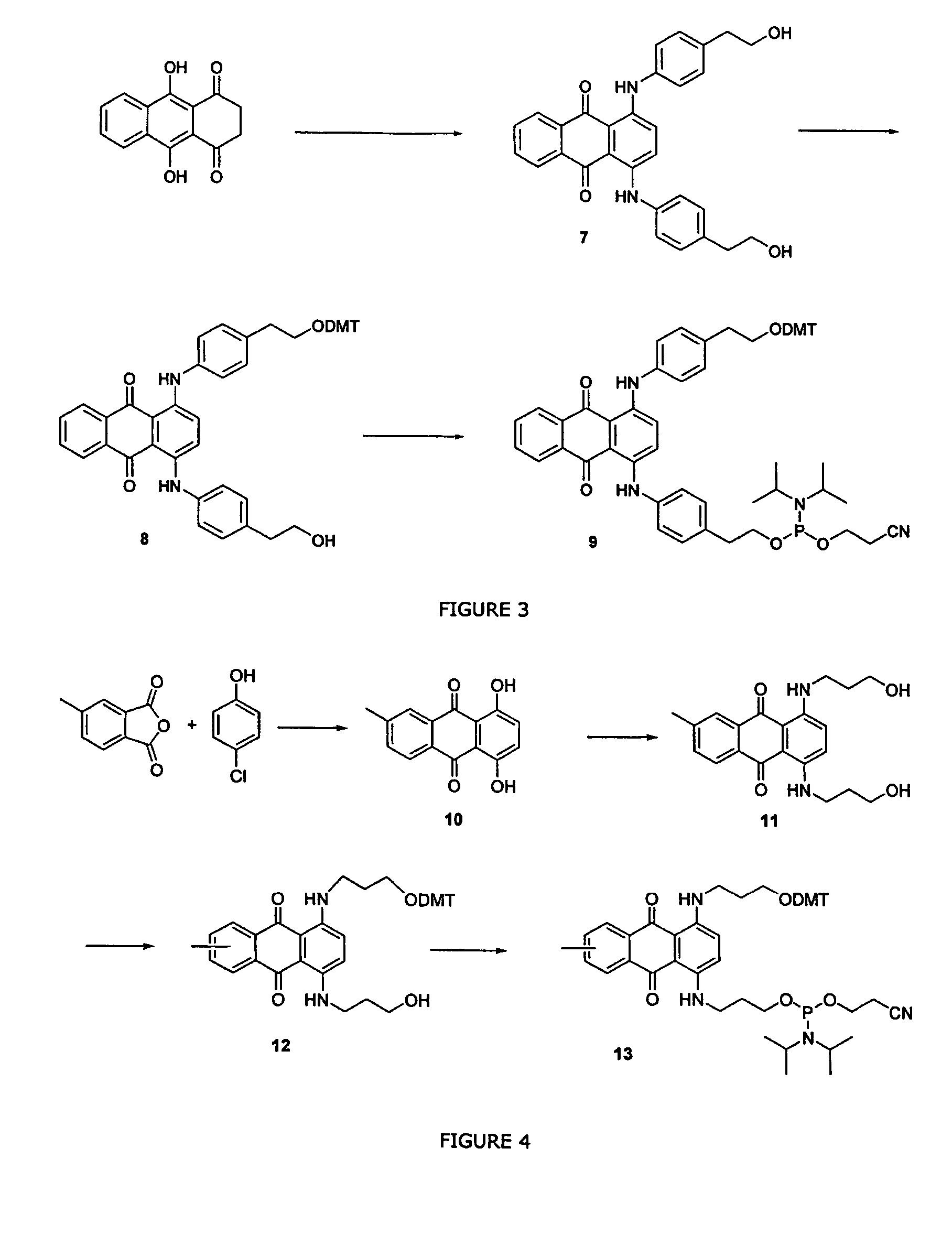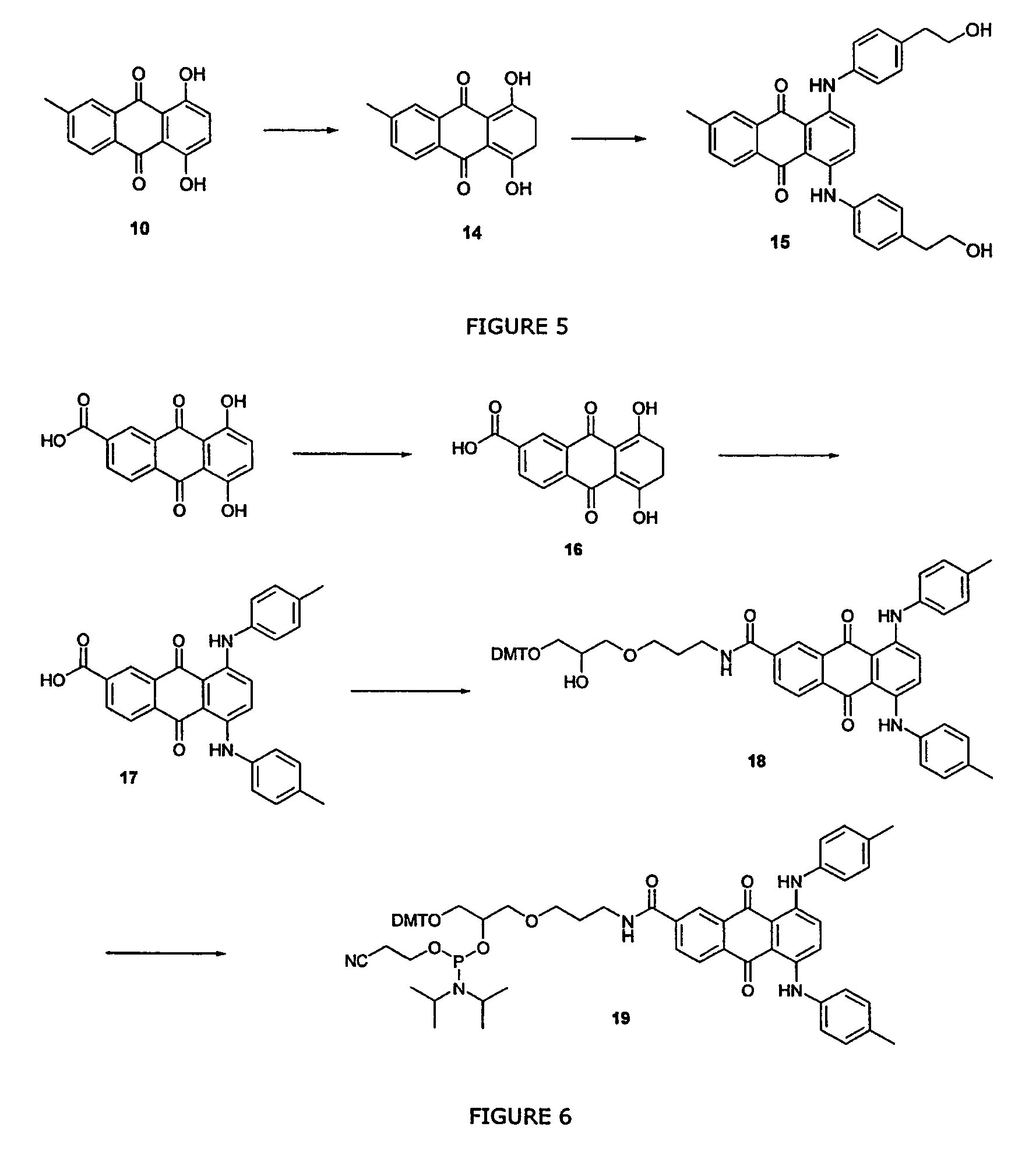Quencher compositions comprising anthraquinone moieties
a technology of anthraquinone and quencher composition, applied in the field of new, can solve the problems of increased quenching, fluorescent quenchers with 2 significant limitations, preclusion of detection, presence of background fluorescence, etc., and achieve the effect of distinct spectral properties
- Summary
- Abstract
- Description
- Claims
- Application Information
AI Technical Summary
Benefits of technology
Problems solved by technology
Method used
Image
Examples
example 1
Preparation of 1-(3-(2-cyanoethoxy(diisopropylamino)phosphinoxy)-propylamino)-4-(3-(4,4′-d / methoxy-trityloxy)propylamino)-anthraquinone (3)
1,4-Bis(3-hydroxypropylamino)-anthraquinone (1)
[0117]Leucoquinizarin (9.9 g; 0.04 mol) is mixed with 3-amino-1-propanol (10 mL) and Ethanol (200 mL) and heated to reflux for 6 hours. The mixture is cooled to room temperature and stirred overnight under atmospheric conditions. The mixture is poured into water (500 mL) and the precipitate is filtered off washed with water (200 mL) and dried. The solid is boiled in ethylacetate (300 mL), cooled to room temperature and the solid is collected by filtration.
[0118]Yield: 8.2 g (56%).
1-(3-(4,4′-dimethoxy-trityloxy)propylamino)-4-(3-hydroxypropylamino)-anthraguinone (2)
[0119]1,4-Bis(3-hydroxypropylamino)-anthraquinone (7.08 g; 0.02 mol) is dissolved in a mixture of dry N,N-dimethylformamide (150 mL) and dry pyridine (50 mL). Dimethoxytritylchloride (3.4 g; 0.01 mol) is added and the mixture is stirred for...
example 2
Preparation of 1-(3-(cyanoethoxy(diisopropylamino)phosphinoxy)propylamino)-5-(3-(4,4′-dimethoxy-trityloxy)propylamino)-anthraquinone (6)
1,5-Bis(3-hydroxypropylamino)-anthraquinone (4)
[0121]1,5-Dichloroanthraquinone (2.8 g; 10 mmol) is mixed with 3-amino-1-propanol (10 mL) in DMSO (50 mL) and heated to 130° C. for 4 hours. The mixture is cooled to ˜80° and added water (150 mL). When the mixture has reached RT the formed precipitate is isolated by filtration, washed with water (2×50 mL), boiled in toluene (200 mL) and the un-dissolved product is isolated by filtration and dried. Yield: 3.2 g (90%).
1-(3-hydroxypropylamino)-5-(3-(4,4′-dimethoxy-trityloxy)propylamino)-anthraquinone (5)
[0122]1,5-Bis(3-hydroxypropylamino)-anthraquinone (1.4 g; 4 mmol) is co-evapourated with pyridine (50 mL) and then resuspended in pyridine (50 mL) added dimethoxytritylchloride (1.4 g; 4.1 mmol) and stirred overnight. The mixture is concentrated and the residue redissolved in dichloromethane (150 mL), washe...
example 3
Preparation of 1-(4-(2-(2-cyanoethoxy(diisopropylamino)phosphinoxy)ethyl)phenylamino)-4-(4-(2-(4,4′-dimethoxy-trityloxy)ethyl)phenylamino)-anthraquinone (9)
1,4-Bis(4-(2-hydroethyl)phenylamino)-anthraquinone (7)
[0124]Leucoquinizarin (2.5 g; 0.01 mol) is mixed with boric acid (1.9 g; 0.03 mol) and ethanol (100 mL) and heated to reflux for 1 hour. The mixture is cooled to room temperature and added 4-aminophenethyl alcohol (4.1 g; 0.03 mol) where after the mixture is heated to reflux for 3 days. The mixture concentrated redissolved in dichloromethane (300 mL) washed with water (3×100 mL), dried (Na2SO4) and concentrated. The residue is purified on silica gel column with MeOH / dichloromethane (1 / 19). After concentration of the appropriate fractions the compound is obtained as a blue solid. Yield: 1.5 g (31%). 1H-NMR(DMSO-d6): 12.2 (2H, s, NH), 8.31 (2H, dd, J=3.1 and 6.0 Hz, AqH), 7.88 (2H, dd, =3.1 and 6.0 Hz, AqH), 7.59 (2H, s, AqH), 7.27 (2H, d, 3=2.7 Hz, ArH), 4.67 (2H, t, J=5.2 Hz, ...
PUM
| Property | Measurement | Unit |
|---|---|---|
| volume | aaaaa | aaaaa |
| coupling time | aaaaa | aaaaa |
| temperature | aaaaa | aaaaa |
Abstract
Description
Claims
Application Information
 Login to View More
Login to View More - R&D
- Intellectual Property
- Life Sciences
- Materials
- Tech Scout
- Unparalleled Data Quality
- Higher Quality Content
- 60% Fewer Hallucinations
Browse by: Latest US Patents, China's latest patents, Technical Efficacy Thesaurus, Application Domain, Technology Topic, Popular Technical Reports.
© 2025 PatSnap. All rights reserved.Legal|Privacy policy|Modern Slavery Act Transparency Statement|Sitemap|About US| Contact US: help@patsnap.com



